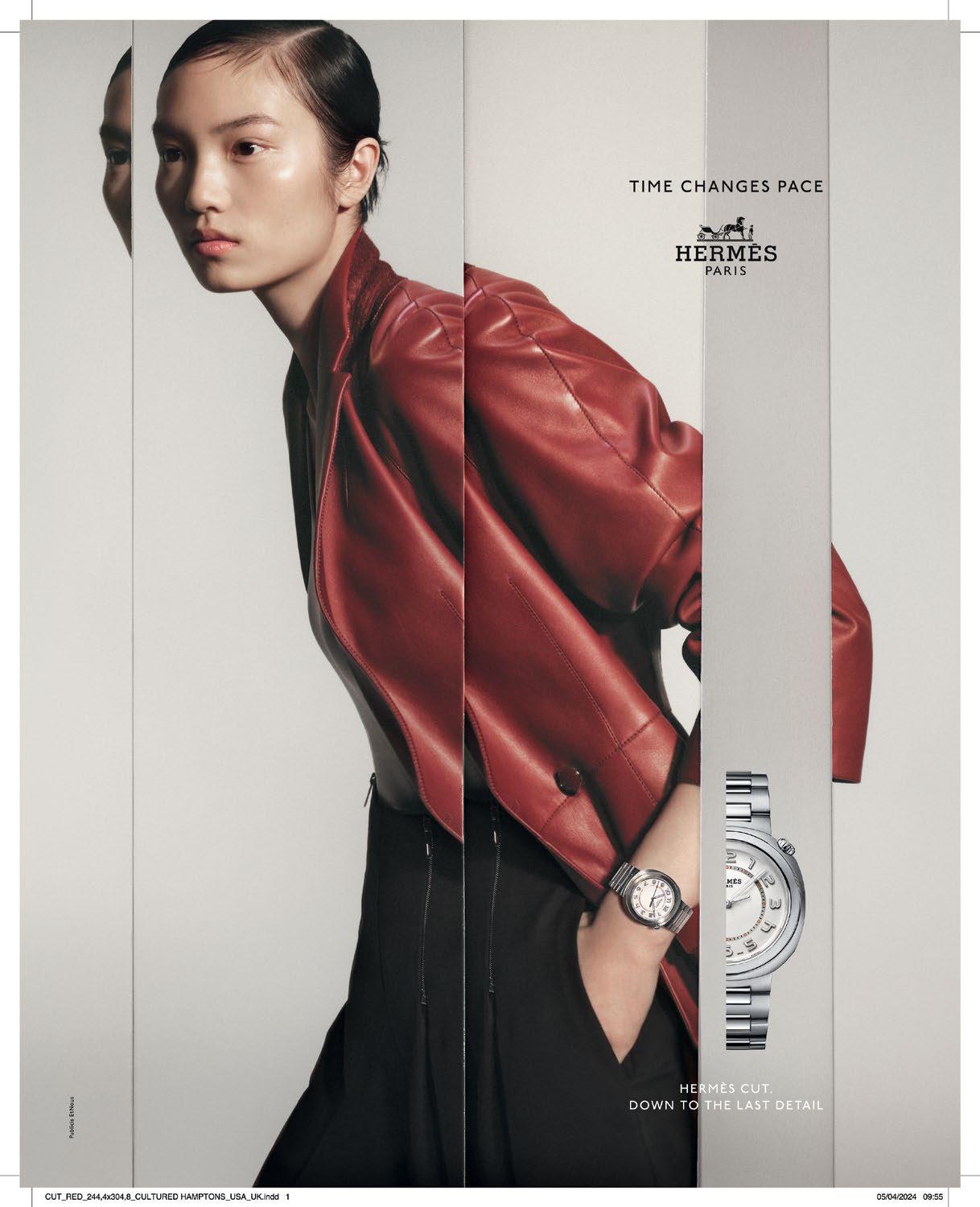




































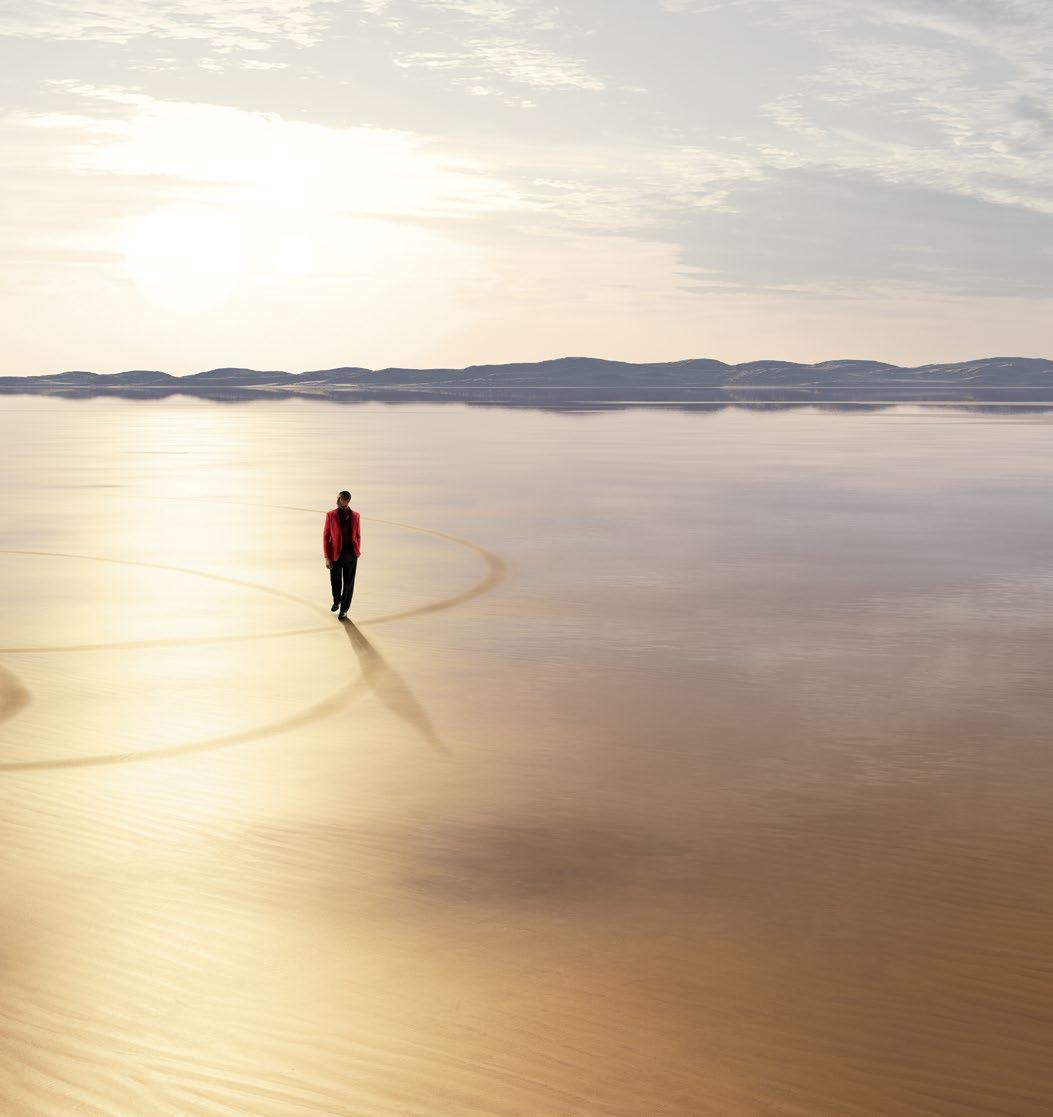






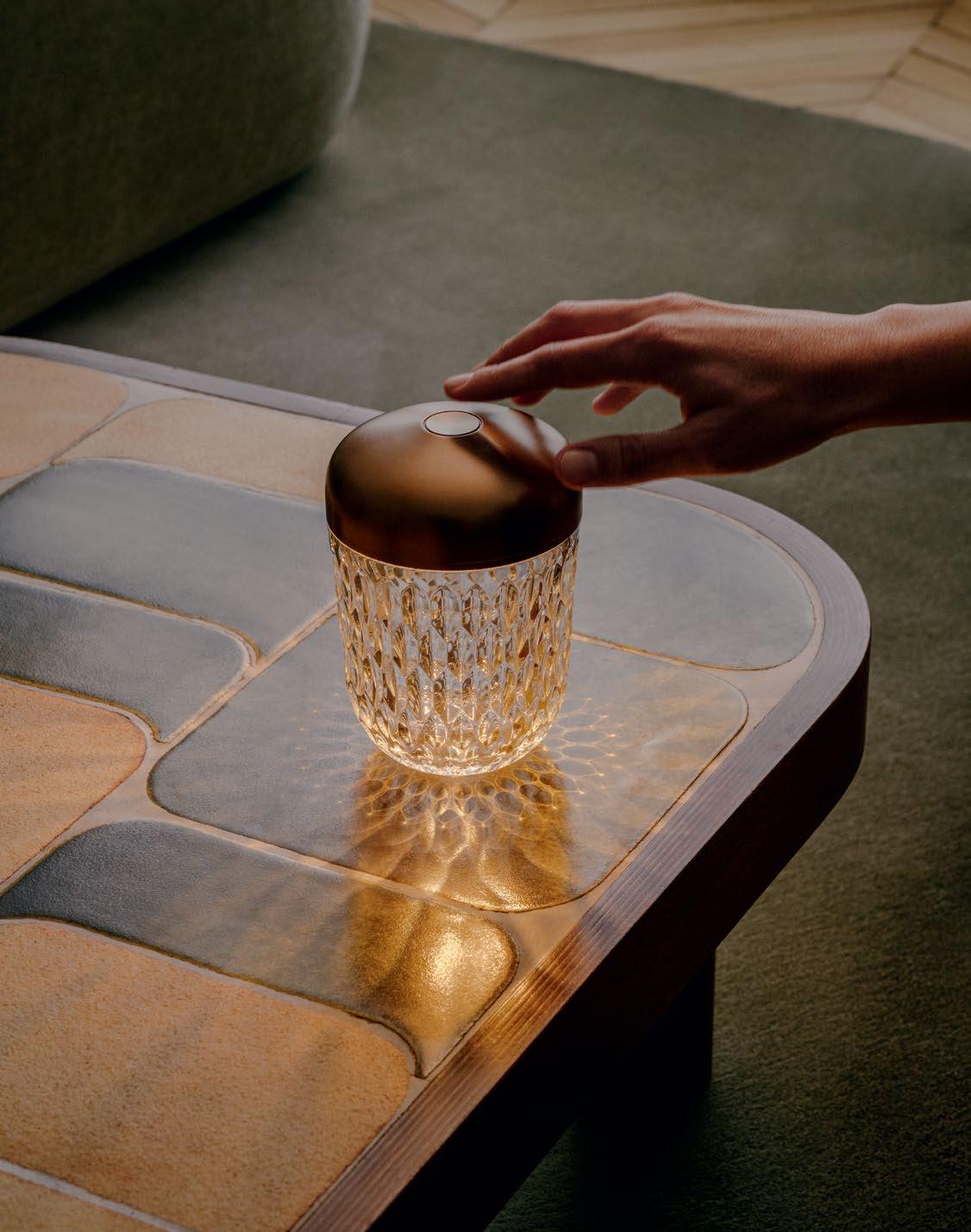

















































Live on the world’s most private island. Estate-style homes on Fisher Island’s pristine shoreline, steps from the exclusive Fisher Island Club, with its award-winning golf course, tennis facilities, spa, beach club and restaurants. The Residences’ unprecedented amenities and white-glove service set a new standard, with five-star dining, resort-style pools, and a waterfront lounge. It’s the pinnacle of coastal living, minutes from Miami but a world away.




















































FOUNDER | EDITOR-IN-CHIEF
SARAH G. HARRELSON
EXECUTIVE EDITOR
MARA VEITCH
HAMPTONS EDITOR
JACOBA URIST
EDITOR-AT-LARGE
JULIA HALPERIN
FASHION EDITOR-AT-LARGE
ALI PEW
SENIOR CREATIVE PRODUCER
REBECCA AARON
SENIOR EDITOR
ELLA MARTIN-GACHOT
ASSISTANT EDITOR
JAYNE O’DWYER
EDITORIAL ASSISTANT
SOPHIE LEE
ART DIRECTORS
ALEXANDER WOLF, CHAD POWELL
JUNIOR ART DIRECTOR
HANNAH TACHER
COPY EDITOR
EVELINE CHAO
CHIEF REVENUE OFFICER
CARL KIESEL
PUBLISHER
LORI WARRINER
DIRECTOR OF BRAND PARTNERSHIPS
DESMOND SMALLEY
PUBLIC RELATIONS
ETHAN ELKINS, DADA GOLDBERG
PREPRESS/PRINT PRODUCTION
PETE JACATY


IT’S THE TIME OF YEAR WHEN WE set our sights on the Hamptons—a creative haven and time-honored escape for artists and writers.
This is CULTURED’s third year celebrating the Hamptons art scene with two exciting supplementary issues, the second of which drops July 26 and will be guest-edited by the inimitable Peter Marino.
These pages highlight the wealth of opportunity that the Hamptons presents— to see world-class art and truly absorb its impact in a natural setting that encourages reflection. My deep thanks to Athena Calderone for generously dedicating her time as guest interiors editor of the issue, and curating a selection of conversations and deep dives with designers and architects inspired by—and dedicated to—the area’s landscape and history.
The issue also celebrates the magic that emerges when some of the most incisive artists of our moment gather in a string of small beach towns to unwind and reset. The incredible Julian Schnabel says it best in his profile: “I’ve had moments where my life was a mess. But paddle out somewhere, drop in on some giant wave and make it, and you don’t care. Painting is like that.” I hope these pages bring you a similar infusion of inspiration and respite.
See you out East.

24
INSIDER TRADING
We asked our favorite East End experts to share their tips and tricks for making the most of the summer months.
26 THE ART DIET: 10 MUST-SEE SHOWS TO VISIT THIS SUMMER
Whether looking for solos from the greats, conversational curation, or even a garden frolic, the Hamptons offer every kind of experience for those pursuing a cultural moment.
28 FASHION FOR THE ESCAPIST
CULTURED rounds up the must-have items for your summer adventures, wherever they may lead you.
30 FOUNDERS OF A FEATHER
STAUD’s Sarah Staudinger and ME+EM’s Clare Hornby discuss how they’re bringing their signature approaches to the East End with the opening of their already essential outposts.
32 A TV EXECUTIVE TURNED DESIGN TASTEMAKER BRINGS HER FAVORITE OBJECTS OUT EAST
Sheila Bouttier, the founder of the cult design hub Galerie Provenance, is working on two pop-up projects in the Hamptons this summer.
34 PIT STOP
What could be chicer than Mytheresa and Flamingo Estate?

“Railroad Racetrack,” their second annual collaborative pop-up in East Hampton, kicking off this month.
36
SPINNING A NEW THREAD
Collector and curator Estrellita B. Brodsky is bringing a Latin American perspective out East this summer.
38 GROWING GEMS IN THE GARDEN
Olivier Reza finds inspiration for his family’s fine jewelry house abroad, at home, and in his own backyard.
38 HAPPY TRAILS
Writer and photographer Susan Kaufman has captured a rapidly disappearing facet of the Hamptons with her latest book: its historical charm.
40 JULIAN SCHNABEL GETS PERSONAL
The famed artist is looking back as he prepares an exhibition of artwork close to his heart at Guild Hall.
46 THE CENTER OF THE FAMILY
Designer Athena Calderone shares the journey behind her family’s life in a mid-century modern Hamptons home.
50 THE THING ABOUT THE NEIGHBORS
Athena Calderone knew she had found a second home by the dreamy enclave of Springs. Only years later did she discover the artistic ecosystem that laid the bedrock for her own creative coming-of-age.
56 WITH ARTWORK IN MIND
Interior designer Sandra Weingort helped turn a monumental Wainscott residence into a home for a museum-worthy collection.
57
Interior designer Jordan Carlyle and his husband Mario MargelistCarlyle, founder of Swiss consignment shop Lux, transformed their farmhouse into an idyllic Hamptons getaway.
58 ROOMS WITH A VIEW
Here, architect Adam Jordan and his client, Athena Calderone, discuss the evolution of his practice—embodied in the standout design of a U-shaped East Hampton property by the water—and his aesthetic sensibilities.

OUR FAVORITE EAST END EXPERTS SHARE THEIR TIPS AND TRICKS FOR MAKING THE MOST OF THE SUMMER MONTHS.
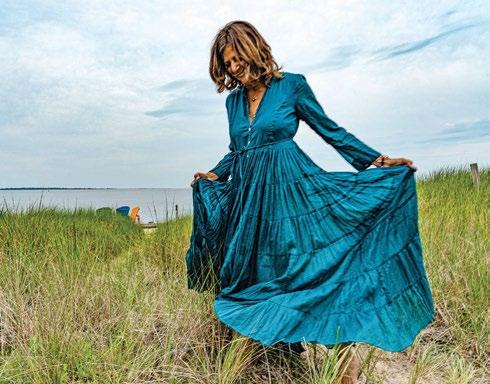
CO-FOUNDER OF IL BUCO, EAST HAMPTON
Which East End art shows are you looking forward to this summer?
“Spin a Yarn” at Guild Hall, “Donna Dennis: Deep Station” at Max Levai’s the Ranch, anything showing at Fairfax Dorn Projects, “Opening Day Lineup” at Eric Firestone Gallery in East Hampton.
I always love what the Parrish Art Museum has programmed: “The Art of Food: From the Collections of Jordan D. Schnitzer and His Family Foundation,” “Carmen Herrera: Estructuras Monumentales,” and “Beyond the Horizon: Interpretations of the Landscape From Women in the Permanent Collection.”
How do the rhythms of your life shift while out East?
Everything slows down, from my morning coffee ritual—out on the Adirondack chairs, with my beloved Bengal cat Keiko, by the water’s edge—to the writing and designing and forever brainstorming work on my laptop, in my PJs or yoga clothes. I’m outside much more, and my breaks are surrounded by nature. I can breathe a bit easier!
What smells, sounds, and textures do you associate with your life here?
The ocean is my biggest draw out East and always has been. The sea air, the changing textures, colors, and turbulence of the ocean and its wildlife—be it dolphins, whales, seals, leaping fish, or the incredible bird life we experience out here.
At my home on Gardiners Bay, I can witness the fishing frenzies of the seagulls, the migrating birdlife, the osprey, egrets, and thousands of other species. What’s your favorite restaurant out East? What should we order?
Before we opened Il Buco al Mare, I usually ate at home. Now I eat our fresh clams, oysters, and crudo every day with crisp rosemary focaccia and our Alimentari Negroni.
I never intended to open a spot out here, where I always came to escape my own hectic restaurant life, but Justin [Smillie, former executive chef of Il Buco Alimentari and al Mare], Grecia [Medrano, current chef de cuisine at al Mare], and our wonderful team make eating out in the Hamptons a joy for me.
Otherwise, I’m a bit old school: American Hotel in the winter, the tavern at the Palm, or the 1770 House, Carissa’s the Bakery for breakfast and lunch, Marram on the ocean when I’m in Montauk or Crow’s Nest if I feel like a hipster vibe. If I am going local to eat with my son, Joaquin, we go for two barstools together at Rosie’s—perfection!
How has the Hamptons scene changed in recent years?
So much more of everything! Some of it is great and new, like 180 the Store in Amagansett. I also love Warm, Ganeaux, Flying Point Surf, and French Presse for the most beautiful bedding. And, of course, Lori Leven’s Love Adorned market in Amagansett Square, and a forever favorite, Henry Lehr.
How do the rhythms of your life shift while out East?
I replace Uber and the subway with biking and the ocean.
What are your go-to fashion items while in the Hamptons?
I have my bloomers on repeat during the day. They’re perfect for riding my bike to the beach. At night, I wear palazzo pants in either terry or linen—fun for a little dance around the pool with my daughter Stevie. What’s your favorite restaurant out East? What should we order?
Carissa’s the Bakery is the best. Order the seasonal salad with seared salmon and the smashed potatoes. What are your favorite local shops? I love E-E Home, directly across the street from my store in Amagansett. I also love Nellie’s for interesting vintage furniture for my home. Balsam Farms is great for fresh local produce.
Which East End art shows and events are you looking forward to this summer? In July, the Antiques & Design Show is always something to look forward to. Guild Hall also always has a great concert schedule.
Favorite Hamptons-based artist to drop by for a studio visit?
Jill Magid is my favorite. The conceptual artist and her husband Jonny [Bauer] come over for a game of backgammon.


What smells, sounds, and textures do you associate with your life here?
The light, the cool sea mist, and the endless beaches. The early morning birdsong signaling spring’s arrival. Our home out here is an old, restored coast guard cottage. I love the historic architecture throughout the hamlets and their deep connection to seafaring life. The history and culture of the sea are integral to the community, encompassing everything from traditional fishing practices to modern surf culture, which is one of my greatest loves.
How has having a child changed your life out East? What are some of the things you enjoy most as a family when there?
Having a child born here has deepened my connection to the land and community. I love watching our little one explore the beaches and wildlife, collecting stones and playing with friends. Beach days are now more spontaneous, and I’ve learned to slow down and be present. We love Amber Waves, where the children connect with food, nature, and community. It’s a joy to see them learning to grow and care for the land.
What era of Hamptons living are you most nostalgic for?
Andy Warhol’s Montauk, Eothen, seemed like a creative escape for artists and musicians in the ’70s. The early days of The Surf Lodge were also special, with intimate performances by bands like the Flaming Lips, Willie Nelson, Patti Smith, and the Kills.
What’s your favorite restaurant out East? What should we order?
The Dock. I like the fluke. They prepare it
simply, which I like.
How do you hope to see the community in the Hamptons evolve?
As a new parent, I spend a lot of my time thinking about education. I hope to see more community events that celebrate the traditions of the Montaukett and Shinnecock peoples, as well as other cultural groups.

FOUNDER OF EPONYMOUS DESIGN STUDIO, SHELTER ISLAND
What, or who, are your cultural touchstones in the Hamptons?
Sylvester Manor is one of the great cultural pillars of the area. Once a Native American hunting, fishing, and farming ground, it has, since 1651, been home to 11 generations of its original European settler family, reflecting America’s evolving tastes, economies, and landscapes. Transformed from a slaveholding, Enlightenment-era provisioning plantation to a farm and pioneering food industrialist’s estate, it is now an organic educational farm where the community celebrates food, the arts, and inventiveness in everyday life with a spirit of fairness and joy. Which East End art shows are you looking forward to this summer?
I am really looking forward to seeing the bold and colorful paintings of Eddie Martinez at the Parrish.
What’s your greatest seasonal indulgence while you’re in the Hamptons? The luxury of time in the garden. Nothing better than spending hours getting your hands dirty and seeing the fruits of your labor.
What era of Hamptons living are you most nostalgic for?
Definitely pre-’90s when it was pre-hype and pre-hysteria.
Favorite Hamptons-based artist to drop by for a studio visit?
Joseph La Piana—I’m a huge fan of his paintings and sculptures.
How do you know when it’s time to return to the city?
It’s never time to go back.

CO-HOST OF THE VIEW AND AUTHOR,
What’s your greatest seasonal indulgence while you’re in the Hamptons?
Sag Harbor is such a magical place. You can get the best of everything—breakfast, coffee, doughnuts, clams, lobster, the list goes on—but my favorite spot is the block party on Labor Day! We have been going to that for years, and it’s such a special memory for my family. It is the perfect way to close out a summer in Sag Harbor. What era of Hamptons living are you most nostalgic for?
Through the beautiful architecture, the sights and sounds of the past live on. My family rents the same beautiful property each year in Sag Harbor, but I’ve spent every summer in the community for 20 years. The property is right next to some of my closest friends and is a summer staple for my family.
What’s your favorite restaurant out East? What should we order?
Paige [at 63 Main]. Great food and great service. It’s a place where everybody knows your name.
How do you hope to see the community in the Hamptons evolve?
Sag Harbor became the setting for my second book, Summer on Sag Harbor, because it is one of my favorite historically Black beach communities. It is one of the only beachfronts in the United States where Black people were allowed to buy property, so it has this rich history that I wanted people to know about. I hope the community continues to thrive.
Favorite Hamptons-based shop to drop by for a visit?
That’s like picking a favorite child! All the shops are very special, very curated. Fishers Home Furnishings is my go-to when I need something for our home. It’s the perfect classic beach style. I could furnish every room with their inventory. I also love Stella Flame. Incredible one-of-a-kind jewelry pieces.
OF EPONYMOUS INTERIOR DESIGN STUDIO, MONTAUK
How do the rhythms of your life shift while out East?
Everything changes for me. Los Angeles is busy, full of energy, and we are constantly on the move—and, of course, a lot of time in the car. Out East, I try to do a complete shift and spend as little time in the car as possible, really take the time to enjoy the summer and the beaches. I look forward to these three months for the other nine months of the year.
What smells, sounds, and textures do you associate with your life here?
Lake Montauk is so beautiful—it looks different every single day. I love seeing the boats out in the water right in front of the house. I know this might sound a bit strange, but I love the humidity—such a change from LA, and also those warm summer nights are so incredible. What era of Hamptons living are you most nostalgic for?
Of course the ’70s with Warhol, but coming in a close second is the 1960s crowd of Jackson Pollock, de Kooning, Motherwell, and Frankenthaler.
What’s your favorite restaurant out East? What should we order?
Love Il Buco al Mare for a fun, long lunch—their mustard greens, the clams, and the fluke, if they have it. It’s local and a must.
Best way to spend a summer evening?
We love having a drink at the Montauket for sunset and then heading to Duryea’s right next door for dinner. If we stay in, having dinner outside and roasting marshmallows for s’mores down by the lake in front of our house with the boys is our second favorite way—and of course, waiting for those lightning bugs to come out, which seem to be much less in number than what I remember!
How has the Hamptons scene changed in recent years?
This is only my second summer in Montauk since the early 2020s as we’ve been spending time traveling and living in LA up until then. I can’t answer very specifically—but change is inevitable, and I can say that it does make every season feel special.
How do you know when it’s time to return to the city?
We wait until the absolute last minute we can before heading back to LA—we are jamming in every last bit of summer all the way until the end of Labor Day.


“SALON”
Where: Eric Firestone Gallery: The Garage
When: Installations rotating throughout the summer
Why It’s Worth a Look: What would a conversation between Miriam Schapiro and Ellsworth Ausby look like? Or Sally Cook and Joe Overstreet? At Eric Firestone’s “Salon” exhibition, their works will be in dialogue all summer long: A rotating curation will foster the mingling of historic artists and their younger contemporaries. With pieces from Pat Passlof, Susan Fortgang, Elise Asher, Regina Granne, and more, it’s a show to look out for.
Know Before You Go: The possibilities are endless in the newly renovated location: With giant moveable walls, exhibition configurations can shift at will to further create a space for dialogue.
HEADING OUT EAST GETS EVEN SWEETER FOR THE ART-MINDED VACATIONER: WHETHER LOOKING FOR SOLOS FROM THE GREATS, CONVERSATIONAL CURATION, OR EVEN A GARDEN FROLIC, THE HAMPTONS OFFER EVERY KIND OF EXPERIENCE FOR THOSE HUNGRY FOR A CULTURAL MOMENT. HERE, CULTURED HIGHLIGHTS THE ESSENTIAL SHOWS OF THE SUMMER.

“BUFLIES” BY EDDIE MARTINEZ
Where: Parrish Art Museum
When: June 30–September 29, 2024
Why It’s Worth a Look: The bold Brooklynbased painter gets a touch sentimental with his latest offering at the Parrish.
Taking advantage of the locale’s soaring ceilings, Martinez created a series of 12-foot-tall paintings specifically for this exhibition, his signature layers of colorful, textured paint on full display. Despite the large scale, the artist leaves behind a few details for keen viewers: Stray shoe prints on the canvases remind the viewer of the work’s massive scale.
Know Before You Go: Family ties bind this exhibition together—Martinez’s then 2-year-old son, Arthur, called butterflies “buflies” in 2021, and a fascination (and this series) was born.

“EAT THE ICE CREAM BEFORE IT MELTS” BY JUDITH HUDSON
Where: Tripoli Gallery
When: June 22–July 22, 2024
Why It’s Worth a Look: New Jersey–born Judith Hudson always has a sense of humor, even when contemplating mortality. With the painter’s latest show— her fourth solo exhibition with Tripoli Gallery—Hudson finds herself contending with the fleeting nature of time. Still loyal to her characteristically punchy watercolors, the artist creates scenes of bathtub gin and existential dread, winestained tablecloths, and broken glasses. Yet, Hudson is never defeatist. In her words, “Life is sweet, getting shorter, but I am determined to keep my sense of humor, and I am going to go down trying.”
Know Before You Go: Hudson pulls inspiration from Tennessee Williams’s A Streetcar Named Desire for her latest show, specifically Blanche DuBois’s “unwashed grape” monologue.

When: June 30–September 29, 2024
Why It’s Worth a Look: Moyer, who has created an inquisitive body of work over her 16-year career, mounts an exhibition on light and materiality. With pieces on view across three of the Parrish’s galleries, Moyer dedicates each room to a different relationship in her practice: Whether evoking the landscape of eastern Long Island or the beauty of concrete, Moyer keeps viewers on their toes, blurring the line between painting, sculpture, and everything in-between.
Know Before You Go: An invitation to play is built into the exhibition: Moyer specifically made marble benches to have visitors take a seat, while handmade backgammon boards are ready for a game in the lobby.

“THE TASK” BY LILIANA PORTER
Where: Dia Bridgehampton
When: June 21, 2024–May 26, 2025
Why It’s Worth a Look: For the Argentinian artist, time has always operated differently: Porter’s perception connotes
a lack of linearity and a sense of dislocation, sensibilities which are on display at her latest exhibition at Dia’s Bridgehampton outpost. Her wide-ranging practice, including works on canvas, prints, installations, photographs, and even plays, revolve around her unique sense of time and the unexpected instances it creates therein, further enhanced by her playful sense of humor.
Know Before You Go: If you can’t catch Porter’s work out East, three of her video works— Matinee, 2009; Actualidades / Breaking News, 2016; and Cuentos inconclusos – Unfinished Tales, 2022—are on view at Dia Chelsea from June 21 to July 22, 2024.

“BEYOND THE STREETS: POST GRAFFITI” CURATED BY ROGER GASTMAN
Where: Southampton Arts Center
When: May 11–July 20, 2024
Why It’s Worth a Look: Graffiti remains a driving force, not only in the art world, but also in a wider cultural context. Permeating the upper echelons of music, fashion, political engagement, and contemporary art, the work is more socially accepted than ever, yet still retains an unbridled, raw edge. “Post Graffiti” brings together some of the biggest names in the space, with featured work from Alexis Ross, CHITO, CRASH, Eric Haze, the Guerrilla Girls, and many more.
Know Before You Go: Beyond the Streets is a global art movement that promotes the work of so-called “agitators and instigators,” exploring the idea of art beyond traditional boundaries.

Where: LongHouse Reserve
When: June 15–August 18, 2024
Why It’s Worth a Look: Escaping into the beauty of nature just got a touch of glamour: With more than 100 pieces of furniture installed, Paola Lenti’s designs now dot the 16-acre gardens of LongHouse, creating peaceful experiences across the sprawling estate. Celebrating 30 years, the Italian furniture brand crafted pieces out of natural woods and eco-friendly fibers for the presentation, the palette mirroring the natural setting.
Know Before You Go: Paola Lenti’s focus on sustainability is incredibly mindful: The use of fibers such as flax and hemp in their yarns is meant to revitalize cultivation methods at risk of disappearing.


“DEEP STATION” BY DONNA DENNIS
When: June 8–July 8, 2024
Why It’s Worth a Look: After all the garden parties and poolside hangouts, go underground with Dennis’s seminal work, which she describes as a subway station at the “bottom of the world.” Originally created in the ’80s—the last in the artist’s series of subway sculptures— Deep Station is at once familiar and uncanny. Inspired by New York’s MTA stations, Dennis likens these underground structures to “tectonic plates” in their subterranean power. The work eerily recalls how the world has changed so much, and yet, not at all.
Know Before You Go: Dennis also took inspiration from the Roman Forum for this sculpture: “I think of the track area as a kind of subterranean river and the platform as a kind of ancient city on the banks of that river.”
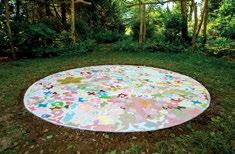
Where: The Church
When: June 23–September 2, 2024
Why It’s Worth a Look: Saying that women aren’t funny is old hat and couldn’t be further from the truth. “Are You Joking?” makes this plain in a monumental group exhibition dedicated to humorous women—and the ways they turn this tired trope on its head. Featuring work from the likes of Lynda Benglis, Katherine Bernhardt, Nicole Eisenman, Pippa Garner, Wendy Red Star, Heji Shin, and many more, it’s a feast for the eyes and rife with laughs.
Know Before You Go: Don’t look up Shin’s Reclining Nude, 2023, if you want to preserve the surprise!
Where: Landcraft Garden Foundation
When: June 8–October 26, 2024
Why It’s Worth a Look: The CubanAmerican artist has always approached outdoor spaces like his own canvas. His latest role as Landcraft’s “Sculpture in the Garden” artist is no exception. Bringing his eye for transformation and a vibrant color palette to the landscape creates a delightful contrast between his industrial sensibilities and the natural environment.
Know Before You Go: Pardo is also known to be a proponent of “living” with one’s work, often blurring the line between fine art and everyday objects.
SUMMERTIME DRESSING ALWAYS EVOKES A CERTAIN DEGREE OF ESCAPISM. WHETHER THEY’RE WORN AGAINST A BEACHSIDE OR URBAN BACKDROP, THE SEASON’S SARTORIAL STAPLES PROMPT WHIMSICAL, EVEN HEDONISTIC, PLEASURES. WITH THE PERFECT SHADES OR IT-BAG IN TOW, ANY ACTIVITY CAN BECOME AN ESTIVAL FANTASY. BELOW, CULTURED ROUNDS UP THE MUST-HAVE ITEMS FOR YOUR SUMMER ADVENTURES, WHEREVER THEY MAY LEAD YOU.
BY ALI PEWA sculptural, alluring choker that stands out poolside or party-hopping. Available at Maison-Alaia.com

This fruitful collaboration always offers an unexpected tilt on vacation style. Retro yet timely, their frames pack a fun, sun-soaked punch. Available at select Loewe boutiques and Loewe.com


The raffia bag gets a new edge with the maison’s latest iteration. Pulling inspiration from Hubert de Givenchy’s summer estate in the South of France, the Plage collection evokes the idyllic locale and its essence therein. Contrasting leather straps add structure while silver hardware gives the Voyou a bit of heft. It’s beachwear with an aloof cool. Available at Givenchy.com
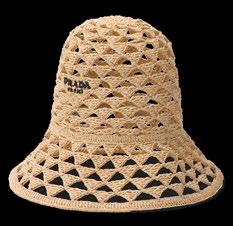
The coastal grandmother, Miuccia style. Available at select Prada boutiques and Prada.com

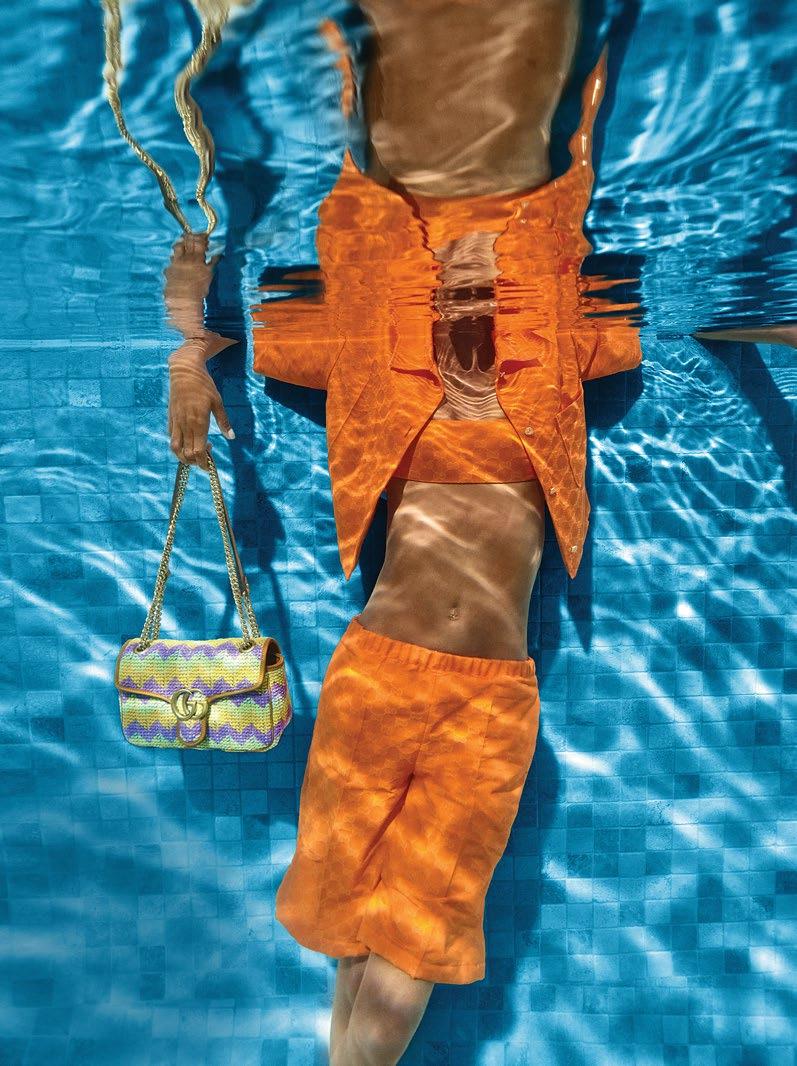
Always ready with a reference, Creative Director Sabato De Sarno called upon Italy’s delightful beach clubs, known as “lidos,” for this latest collection. Designs are saturated in “dopamine dressing” colors and fun prints. Effortless, joyful separates recall an indulgent day journeying into an even more raucous night. Available at Gucci.com
Loro Piana’s resort collection is a luxe take on the beachside hippie. Available at LoroPiana.com

An updated interpretation of classic East Coast prep. Available at select Miu Miu boutiques and MiuMiu.com
FOR STAUD ’S SARAH STAUDINGER AND ME+EM ’S CLARE HORNBY, FASHION MEETS THE WEARER WHERE THEY ARE. THEIR RESPECTIVE LINES OFFER BREEZY EVERYDAY PIECES WITHOUT SACRIFICING ELEVATED DESIGN—YET THEIR APPLICATIONS COULDN’T BE MORE DIFFERENT. STAUDINGER’S SYNERGETIC EYE FOSTERS UNEXPECTED COLLABORATIONS AND PLAYFUL GARMENTS, WHILE HORNBY’S BRITISH BENT LEANS CITY-MINDED AND UNDERSTATED. BELOW, THE TWO FOUNDERS DISCUSS HOW THEY’RE BRINGING THEIR SIGNATURE APPROACHES
TO THE EAST END WITH THE OPENING OF THEIR ALREADY ESSENTIAL OUTPOSTS—AND WHAT THE SUMMER SEASON HAS IN STORE FOR THEM.
BY ALI PEW
What is the inspiration for the Hamptons store?
We design our stores to feel like you’re at a friend’s house: simple, clean, and unpretentious with homey details. STAUD Hamptons started with our DNA, and then we played with textures like raffia fabric and coastal colors like deep blues and tan. What do you associate with Hamptons style?
Nancy Meyers. Clam bakes. Bike rides. Easy breezy, smart separates. Effortless beauty. Sophisticated and relaxed. Diane Keaton.
Do you have any special collaborations or projects for the Hamptons store?
We’re doing a STAUD Sea pop-up down the street from the store for the season. It’ll have our entire swim collection— cover-ups, accessories, and essentials for summer.
What does an ideal summer day look like for you?
Wake up late. Work out. Brunch al fresco with friends and family. Jamón and eggs. Beach. Hot tub. Ice Cream. Movie. Bed. What was your first Hamptons experience or impression?
Too many people sharing one room. Giant hydrangeas.


What is the inspiration for the Hamptons store?
The polished take on coastal living in the Hamptons is very unique. This clash of elegance and sophistication with the laid-back feel that the sea evokes felt like something we had to celebrate, which comes through with the whitewashed floorboards contrasting a high-gloss desk in a vibrant mustard. How does the design of the space reflect the ethos of ME+EM?
We’re very proud to be a British brand, so working with British creatives on our U.S. stores felt important. There are some beautiful pieces—including lighting from PINCH Design, fabrics from Rose Uniacke, and custom ceramics from ceramicist Tina Vaia. What was your first Hamptons experience or impression?
There’s something about the Hamptons that reminds me a lot of home. It’s a mix of Notting Hill elegance with the charm of the Cotswolds and style of Ibiza. What does an ideal summer day look like for you?
Spending time with my two daughters, good food, wine, and conversation are the key to a perfect day. We might go to the River Cafe, which is one of our favorite London restaurants. The food and wine are unbeatable, and the setting, particularly in summer, is perfect. What are you excited about for summer 2024?
I’m a big fan of short stories and love the Irish writer Claire Keegan’s work. I also really enjoy Elizabeth Day’s podcast How To Fail [With Elizabeth Day]. She’s a great interviewer, and her conversations are always a lesson in resilience.


the art-world establishment dismissed textiles as the ugly stepchild of “real” contemporary art. More recently, the outdated hierarchy between art and craft has come crashing down—and collector, curator, and art historian Estrellita B. Brodsky is witnessing the shakeup from the front row. In the month between when she closed the exhibition “Spin a Yarn” at her Manhattan nonprofit, Another Space, and reopened it at Guild Hall in East Hampton for the summer, she sent one of the works on loan (by the Indigenous Argentinian artist Claudia Alarcón) to the central exhibition at the Venice Biennale. “I got a kick out of how many artists were in the Biennale who we had shown before,” she recalls.
The artists spotlighted by Adriano Pedrosa, the first Latin American curator to lead the Venice Biennale, were new to many art world insiders—but not to Brodsky. For decades, she has studied Latin American art and, along with her husband, real-estate developer Daniel Brodsky, assembled a wide-ranging collection with the region at its heart. She also endowed a curatorial position dedicated to the field at the Tate in London, as well as at the Metropolitan Museum of Art and the Museum of Modern Art in New York.
Brodsky takes pains to say she is no textile expert. But the exhibition at Guild Hall in East Hampton, where she has had a home for 50 years, illustrates her interest in looking beyond the welltrodden paths of art history. The works on view, culled from her collection along with those of friends and colleagues like the late legendary curator Jack Lenor Larsen, range from examples by fiber-art pioneers, such as Sheila Hicks and Cecilia Vicuña, to lesser-known practitioners reviving ancient Indigenous techniques, like Mónica Millán and Chonon Bensho. “I like to support young and old artists who don’t have the recognition they deserve,” says Brodsky. “I think that’s important, to be an activist for the field.” Here, she gives CULTURED an inside look at the philosophy and encounters that have shaped her intrepid collection.
How did “Spin a Yarn” first come about? It’s an idea I’ve been interested in for a long time—textile as an art form and how underappreciated it had been. We are looking back to the ancient Americas and how they devleoped intricate and sophisticated weaving methods and seeing the idea through to contemporary artists. Text and textiles share the Latin root textere, “to weave.”

[Thread] is an alternative to the written word to convey information. How much of the work in the show is from your collection?
I often start from my own collection because it’s easiest to borrow from. It’s a great excuse to show works that don’t have a permanent home. One that I love is by Mónica Giron, from Argentina—little pullovers for these birds in Patagonia. It’s so touching and sweet. There’s also a 12-foot-tall inflated sweater [depicting] Lionel Messi by Lucrecia Lionti. That’s not one you can hang up at home.
“WHEN YOU CAN AFFORD IT AND DON’T DO IT, THAT’S WHEN YOU KICK YOURSELF.”
—ESTRELLITA B. BRODSKY
Has your interest in contemporary textiles sparked an interest in older textile traditions?
I have very few pre-Columbian textiles. I’ve started looking at them more after [organizing] this show—they’re just so beautiful and intricate. Some of them date back to before the common era. At Guild Hall, we are only showing a Huari hat and sewing kit from my collection. I could have borrowed others, but there are conflicting attitudes toward showing works from the ancient Americas outside an encyclopedic museum, or if they were used in funerary rites. There is a sensitivity to Indigenous communities that we won’t risk.
Where does the story of your personal collection begin?
I came from a family that appreciated art, and I’m a frustrated artist. I got my

master’s in Impressionist art at Hunter College—they didn’t offer a specialty in Latin American art. Then I went back to school [at the Institute of Fine Arts at New York University] for my PhD focusing on Latin American art.
The academic has fed the collecting and the curating, and it has fed the activism, too. The truth of the matter is that even today, people say it’s so accessible to see Latin American art, but it isn’t. There are maybe a handful of artists who are [widely accessible]. Latinos and Latin American artists working in the U.S. are always blamed for being derivative, but my interest is to revisit the history that these artists were making together, so we give credit to overlooked masters.
What is the first piece you ever bought?
A Picasso “Tête” painting was the first
“I CAME FROM A FAMILY THAT APPRECIATED ART, AND I’M A FRUSTRATED ARTIST.”
—ESTRELLITA B. BRODSKY
important work I bought. I still love the work of Picasso—he was Spanishspeaking, you know.
What is the piece in your home that sparks the most conversation?
A work by [Argentinian artist] Marta Minujín. It’s a burnt coat on a skewer with a crown of thorns on the top and coal on the bottom. That was a conversation piece. The Jewish Museum borrowed it for her recent show.
What keeps you engaged in collecting? I feel fortunate to have had friendships
with artists like Jesús Rafael Soto, Julio Le Parc, and Marta. We have to give them a lot of thanks for sticking with it, especially since some of them had to suffer through military dictatorship. They fought for their beliefs in a real way. Is there one piece that got away, or that you still think about?
I’m just looking at one of the Jeffrey Gibson sculptures coming up for auction— that or an identical one got away. There’s also a [Lucio] Fontana. I remember having a discussion on the street [with my husband] and I said, “I think I should buy it,” and he said, “What are you doing?” I didn’t do it. When you can afford it and don’t do it, that’s when you kick yourself. What was the most challenging piece in your personal collection to acquire?
I have a Tomás Saraceno constellation piece that is too big to bring into my home.
It’s two meters wide, and it just doesn’t fit through doorways. You’d have to cut it down and re-solder it. It now lives at UOVO [the art storage facility]—until it goes to a museum, hopefully. It’ll find a home one day. Who is an artist you are particularly excited about right now?
I really like Alvaro Barrington—he’s another who might get away. He was born in Venezuela and lives in London. I have one piece by him, but the one I really wanted was a concrete block that weighed more than 100 pounds. I’ve learned from my Saraceno constellation.
What is the most impractical work in your collection?
I have a beautiful sculpture by [Uruguayan sculptor] Gonzalo Fonseca. We could only put it in one place, where it had reinforcements. That thing is not moving—ever.

WHAT COULD BE CHICER THAN MYTHERESA AND FLAMINGO ESTATE ? “RAILROAD RACETRACK,” THEIR SECOND ANNUAL COLLABORATIVE POP-UP IN EAST HAMPTON, KICKING OFF JUNE 28. HERE, THE MASTERMINDS BEHIND THE EXPERIENCE— MYTHERESA NORTH AMERICAN PRESIDENT HEATHER KAMINETSKY AND FLAMINGO ESTATE FOUNDER AND CREATIVE DIRECTOR RICHARD CHRISTIANSEN—TALK SOPHISTICATED PLAY, WEIRD HISTORIES, AND VERY EXPENSIVE STRAWBERRIES.
Richard Christiansen: I know when we discussed this year, we were like, “Should we throw out the car thing altogether and just build a yacht club?” East Hampton is fancy, but there’s nothing to do, so [last year] people came in and had so much fun. One of the important things for me this time was a lot of movement, noise, and constant motion.
Heather Kaminetsky: Last time we had the stationary car, and there was a lot of movement but not in the center. Bringing energy to the center was super important. Even though we’re in the middle of town, we’re a little on the outskirts, which was an advantage. It became a destination. Christiansen: This year, it’s going to as well.
Kaminetsky: The creative vision that you put together is amazing. For Mytheresa in particular, it’s a physical manifestation of our digital platform: If Mytheresa came to life, what would this feel like? You did an amazing job of creating this energy in the front room. The back room is very moody and chic. It has a sexiness to it. It gives people a minute to breathe. Christiansen: Play is such an important piece of DNA for both our brands. Especially now in a digital world, analog play is such a precious thing. The original idea came from a sculpture in LACMA by Chris Burden called Metropolis II. It’s a little slot car machine. We thought, Wouldn’t it be interesting if we could take that idea of a kid’s slot car racetrack but make it enormous? Could we have the cars going around iconic pieces but also around iconic pieces of architecture? It’s executed in a way that feels sophisticated and elevated, not junior at all. As soon as people see it, they’re going to smile. It’s so outrageous and ridiculous.
Kaminetsky: You also recreated the “Inconvenience Store.” That looks amazing this year.
Christiansen: I had to. The original concept was 30 products that are hard to make, grow, and harvest. They’re all a pain in the ass. I care so deeply about growers and makers in the same way you care about creators and materials. The store is our version of 7/11, just full of stuff that’s really fussy—the glory of all things inconvenient. Spice strawberries are the number one. They sell out constantly. Harry’s Berries, where we get the strawberries from, is an iconic farm in California. They’re $40 a pound, but it’s an amazing farm. They treat their soil so well. If you’re a chef and you like strawberries, that is the one place in America to get them.
Kaminetsky: Somebody came yesterday as we were working on the space and was like, “Can I buy the strawberries?” We
were like, “No, we’re not open.”
Christiansen: Not yet. The feel of everything is really different this year. It’s a bit ’80s. I was just in Japan and saw a lot of stuff from the height of Japanese ’80s shopping culture. I was like, Oh, this feels like what we’re doing
Kaminetsky: We are going to have some extreme pieces on the jewelry wall this year, too. If you’ve ever been to Formula 1, they have these lounges where there are beautiful accessories and items. These are not just small little earrings. These are statement pieces to start a conversation. Christiansen: I can’t believe you built that out.
Kaminetsky: There’s so many pieces. We have the bones of the auto body shop. This year, it was a totally new production of the space while keeping the bones of
“IT’S A BIT ’80S. I WAS JUST IN JAPAN AND SAW A LOT OF STUFF FROM THE HEIGHT OF JAPANESE ’80S SHOPPING CULTURE. I WAS LIKE, OH, THIS FEELS LIKE WHAT WE’RE DOING.”
—RICHARD CHRISTIANSEN
the auto body shop. We’ve been working on it since November. Last year, we did it in 12 weeks.
Christiansen: We have air conditioning this year, which is wow.
Kaminetsky: And a dressing room! And a lot more product you can take from the store. Last summer, we had men’s, women’s, and kids. Now, we have dog, too: There are Bottega Veneta dog bowls. Christiansen: We’ve also got some beautiful lavender Porsche Taycans outside. I didn’t know that Porsche has this weird, wonderful history in car colors. That idea started because Flamingo is near the Huntington Botanical Gardens where you can breed your own hybrid rose. One of the original thoughts we had was, Could we do a rose to push one of the iconic Porsche colors? They have this incredible lavender. We never made the rose, but they did produce the cars.
Kaminetsky: You could come test-drive them almost all summer.


BOUTTIER , THE FOUNDER OF THE CULT DESIGN HUB GALERIE PROVENANCE, IS WORKING ON TWO POP-UP PROJECTS IN THE HAMPTONS THIS SUMMER.
BY LEE CARTERSHEILA BOUTTIER CAN’T seem too sit still. The former TV executive darts on and off screen during our video call in search of items from around her Los Angeles home to show me. The objets d’art, vintage treasures, and assorted antiques she finds and gingerly rotates for the camera are the latest offerings from Galerie Provenance, an interior design “experience” she founded in 2017 and operates out of her house, as well as an annex in Inglewood. Shown by appointment only, her bespoke curations have earned a cult following in just a few years—and this summer, she’s expanding to the East Coast with two pop-ups.
She speaks enthusiastically—nearencyclopedically—about her finds. “I’ve really gotten into Hugo Elmqvist,” she says, holding up a bronze vessel by the preeminent Swedish Art Nouveau sculptor. “He patented his own casting method in 1902 and began working in bronze. I love how the patina ages and evolves.” She cites French designer Charlotte Perriand and Danish sculptor Arne Bang as current crushes, as well as Swedish furniture maker Axel Einar Hjorth. “Sweden has a lot of lakes and therefore a lot of lake homes,” she says. “Axel created a line of pine furnishings in the 1930s for these homes, each named after an island in the Stockholm archipelago. They’re extremely collected today.
Bouttier also seeks out humbler objects by unknown makers. She lifts what she calls a root bowl made sometime in the 1800s and another rustic dish dating to 1747, whose split burl wood has been repaired, if unceremoniously, with a large metal staple. Art or craft, attributed or not, Bouttier likens her taste to “a well-
“YOU DON’T WANT TO EAT JUST ONE THING ALL THE TIME. THE BEAUTY IS IN THE MIX OF PATINAS, MATERIALS, MAKERS, AND, OF COURSE, PROVENANCE.”
balanced diet.” “You don’t want to eat just one thing all the time,” she continues. “The beauty is in the mix of patinas, materials, makers, and, of course, provenance.” A second career in design represented an unlikely turn for the veteran television executive behind mega-hit talk shows like The Tyra Banks Show and The Ellen DeGeneres Show. Yet,


after more than two decades in daytime showbiz, she decided to bid the business adieu in the mid-2010s, around the same time she began construction on her Brentwood home.
“We were building a house with the amazing architect William Hefner,” she recalls. “I had never considered my interior design voice, but we were building this beautiful home, and I realized I had to discover what that is.” So she used her “producorial skills” from her career in TV to tell the stories behind these objects. “They’re so full of stories; they have life and soul,” she says. “I started studying
them and eventually turned that passion into Galerie Provenance.”
Bouttier’s own story—her personal provenance, if you will—offers a clue to her newfound design affinity. “I come from a very creative, artistic family,” she says. “My dad’s a concert pianist, my uncle was a Juilliard-trained concert cellist, and my mom was in the theater.” Add to that her grandfather, Benjamin Abramowitz, a prolific multimedia artist with a career spanning seven decades. His works can be found in the Metropolitan Museum of Art and the Phillips Collection, as well as with Bouttier.

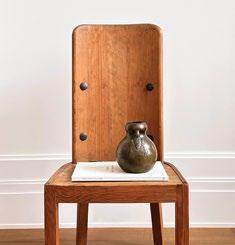
“I grew up surrounded by his art and loved it very much. It’s art you want to live with,” she says. When she sees clients in her home, she places her wares in situ, among her grandfather’s oeuvre. “It’s so magical when people come into the house to view a bowl or a chair and say, ‘What is this painting? Who’s the artist?’ They really fall in love with his works.”
This summer, Bouttier is headed to the Hamptons with two events. First, she’s collaborating with Sag Harbor design shop the 1818 Collective on an exhibition of her grandfather’s paintings, works on paper, and small sculptures through
Labor Day. And during the month of July, she’s bringing her home-gallery concept to Bridgehampton with an appointment-only pop-up shop in a private home.
“I found a lovely home that’s clean and simple, with a very beautiful palette,” she says. “It’s very similar to how I work now—intimate, one-on-one.”
She plans to bring furniture and objects by her faves: Perriand, Hjorth, Bang, and Elmqvist, among others. “I thought, Wouldn’t it be great to bring some of them to the East Coast, where people can come in and see the pieces in a realistic setting? It really makes a home feel like a home.”

This summer in Sag Harbor, a selection of works by Sheila Bouttier’s grandfather, the acclaimed artist Benjamin Abramowitz, are on display at the 1818 Collective. The selling exhibition of nearly two dozen items— paintings, works on paper, and small sculptures—is curated by the design shop’s founders Analisse Taft-Gersten and Kristin Fine, in collaboration with Bouttier and Galerie Provenance.
Born in Brooklyn in 1917, Abramowitz quickly earned a spot as one of the most prolific artists of the 20th century. By only 35, his pieces had been featured in 13 solo shows in prestigious museums and galleries, predominantly around Washington, DC, where he based his practice. His body of work ranged from Realism to Impressionism to Abstraction— steeped in Modernism, but resisting categorization.
“He created art his entire life,” recalls Bouttier, his only grandchild. “Because he worked for so long, there’s a wonderful breadth to the items he created. People are blown away by the variety of his output.”
OLIVIER REZA FINDS INSPIRATION FOR HIS FAMILY’S FINE JEWELRY HOUSE ABROAD, AT HOME, AND IN HIS SAGAPONACK BACKYARD.
BY SOPHIE LEEOlivier Reza’s jewelry sprouts across a collarbone or blooms from an ear and down a neckline. The designer’s gem-filled creations make up the second chapter of Reza, founded in Paris in the 1950s by Olivier’s father, Alexandre. When it came time for the elder to step down 15 years ago, Olivier took up the torch, shifting from a career in finance to continue his father’s legacy, thereby “discovering a passion for his world.” In 2020, Olivier moved the French house to New York, where he’s been based for over two decades. With the change in landscape, Reza’s Parisian bent melded with the American attitude of its new creative head.
During the summer, and when he’s able to pop over during the colder months, Olivier spends much of his time out East at his home in Sagaponack. There, he finds a well of inspiration in his backyard
and the abundant nature that populates the region—even in the “mesmerizing” weeds. “It’s really beautiful when the branch is a certain shape and then there are the leaves and then there are the flowers,” he says of the flora that inspires the characteristically spare pieces he designs. “It’s not just one element or too much of one thing.”
Though he makes regular trips to France to maintain both his and the brand’s connection to their Old World roots, Olivier has firmly situated Reza in our era. He emphasizes its unique digital focus, as opposed to the typical brick-and-mortar model most jewelers run on. “Beauty is everywhere,” he says of the many big moves the brand has navigated in recent years, to the States and the web.
“No one has a monopoly on beauty.”
WRITER AND PHOTOGRAPHER
SUSAN KAUFMAN HAS CAPTURED A RAPIDLY DISAPPEARING FACET OF THE HAMPTONS WITH HER LATEST BOOK: ITS HISTORICAL CHARM.
BY SOPHIE LEEAs the temperature climbs into the 80s, New Yorkers start clogging up the Montauk Highway, heading to the eastern tip of Long Island. “The biggest misconception about the Hamptons is that it’s only a summer destination,” argues writer and photographer Susan Kaufman. “Fall is actually my favorite season out East—it’s less crowded, flowers are still blooming, and the colors of the changing leaves are spectacular. Everything just feels more peaceful and laid-back.”


tribute to
lined boutiques. Now a part-time resident of Amagansett, Kaufman first traveled to East Hampton at the age of 8 to visit her aunt and uncle. “I remember passing duck farms and endless potato fields as my family drove along the Montauk Highway back in the ’60s. The whole area is more built up than it used to be, and many smaller cottages have been leveled and replaced with grander homes—including my aunt and uncle’s cottage,” she recalls. “There are still many areas of the Hamptons that have remained untouched, but sadly there are fewer and fewer.”
Following the success of Walk With Me: New York, her 2022 publication now in its 10th printing, Kaufman turned her lens to the rapidly shifting landscape of her local haunts. “I used the same template—each chapter is a different town followed by an illustrated map,” she explains.
“There are photos of the natural beauty to be found in the Hamptons and [fewer] shop fronts.” Inside the tome, readers will find homes that, much like Kaufman’s, are a testament to the region’s legacy—and the people who maintain it. “Renovating our house was a time-consuming labor of love for the first few years,” admits Kaufman, “but it was worth everything we put into it.”

08 - 24 - 24 07 - 27 - 24 10 - 27 - 24
09 - 21 - 24

The famed artist is looking back as he prepares an exhibition of artwork close to his heart at Guild Hall.
BY JACOBA URIST


Schnabel and Kugelberg collaborating behind the scenes on set.
Photography by Sean Thomas
“I’ve had moments where my life was a mess. But paddle out somewhere, drop in on some giant wave and make it, and you don’t care. Painting is like that. It has to do with freedom, really.”
JULIAN SCHNABEL
JULIAN SCHNABEL arrives at 10 a.m. sharp for what will end up being a two-and-ahalf hour sprint through his life and work. Our first stop is his son Vito’s eponymous gallery in Chelsea, where the 72-year-old artist’s latest show is on view through July. Schnabel suggested visiting the mini-retrospective, which gathers paintings he made between 1978 and 1987, before we zip downtown to his home and studio. There, he is selecting prize examples from his own holdings for an exhibition at East Hampton’s Guild Hall opening this August.
Everyone in the art world has preconceived notions about Julian Schnabel. He has lived many lives since his rise in the New York art scene in the 1980s with the reputation of an artist bad boy. But the art speaks for itself. His gigantic smashed-plate paintings, inspired by the mosaic benches of Antoni Gaudí, feel as radical today as when he unveiled the first one in 1978. In the nearly five decades since, Schnabel has painted a stream of masterworks on velvet and tarp—all while honing an illustrious film career. Schnabel is a Cannes Film Festival and Golden Globes Best Director, as well as an Academy Award nominee. In the art world, he injected a dose of frenetic maximalism into a minimalism-saturated milieu. In Hollywood, he’s told the stories of tragic geniuses like Jean-Michel Basquiat and Cuban writer Reinaldo Arenas. Beneath all of it lies a relentless drive to create.
On this misty New York morning, Schnabel has a gentle, wistful aura. “I haven’t seen this painting in probably 30 years,” he says as he surveys the 11-by-17-foot plate painting Australia, 1986, which depicts the infamous 19th-century bushranger Ned Kelly in a frock coat. “It’s interesting to walk up and see what somebody made who might have happened to be you.”
The artist is at a contemplative point in his life. The process of revisiting his work in these two very different settings—Manhattan and the Hamptons—has him reflecting on the evolution of both his oeuvre and personal life. A parent of seven (spanning 40 years), he’s ready to muse about fatherhood. “There’s something unusual and amazing that your son or children care at all about what you were doing,” he says as he takes in the work hanging in his son’s gallery. “And then, that your son is trying to define and clarify and present that to the public in some way.”
Schnabel’s driver shepherds us to Vito’s West Village space to view the show’s second chapter. The SUV is littered with toddler detritus from his youngest child, Esmé—a baby doll and a toy stroller. Titled “Van Gogh’s Trees of Home for Peter Beard 2020,” this exhibition features more recent plate paintings. Made in 2020, they are as much a love letter to post-Impressionism as to Schnabel’s late friend, the photographer Peter Beard, who died that year

Beard was a close confidant and neighbor of Schnabel’s in Montauk; they would often share tuna fish sandwiches, Clamato, and vodka at Beard’s garden table. We are meeting 11 days after the death of the artist Frank Stella (who, Schnabel proudly reports, once told an art historian he admired Schnabel’s work), and mortality seems top of mind. “Everything that’s not in the painting doesn’t exist,” Schnabel says. “You and I are transient. On the other side of this...”—he points to the confines of an artwork—“no-man’s-land. But inside these things, when I was alive—I was responsible for that. When you make something, it’s about leaving it there so someone could commune with it or feel like you’re communing with them through that thing.”
Like everything Julian Schnabel, the legend of his home precedes our arrival. Designed by the artist, Palazzo Chupi is a bubblegum-pink hallmark of the West Village skyline. Schnabel and his family occupy most of the neo-Mediterranean, which also contains his massive studio. (Two other neighbors, according to Schnabel, reside in the building as well.) The elevator to his foyer opens to reveal a museum-quality collection throughout the regal living quarters—Pablo Picasso, Salvador Dalí, Frank Stella, Jamie Nares, Ron Gorchov—alongside a trove of Schnabel’s own painting and sculpture.
Staff members instantly pepper the artist with questions when we enter. His latest film, In the Hand of Dante, based on Nick Tosches’s novel of the same name and starring Oscar Isaac, Gerard Butler, Al Pacino, and Gal Gadot, is in post-production, and certain frames require immediate attention. In a cavernous space Schnabel calls the piano room, which he’s currently using to edit the film, we wait for his wife—screenwriter, film editor, and interior designer Louise Kugelberg. Schnabel gestures to an Andy Warhol here, a lifesize wax sculpture of Schnabel by Urs Fischer there.
The couple are regular collaborators, whose creativity feeds off each other. Kugelberg co-wrote and edited At Eternity’s Gate, as well as his latest film, which she is working on alongside co-editor Marco Spoletini. Kugelberg has also designed Schnabel exhibitions at San Francisco’s Legion of Honor and the ARoS Aarhus Art Museum in Denmark. “For the show I had at the Musée d’Orsay, she designed the walls so you could hang paintings salonstyle,” he says proudly, adding that, after his paintings were removed, the museum placed Van Goghs and Gauguins in the same room, leaving Kugelberg’s configuration (at least, for a time) intact. The pair settle before a monitor, where they replay a crashing wave over and over, second by second, until they feel confident they have captured the crest perfectly.
A dedicated surfer and a Hamptons cultural fixture, Schnabel knows his way around a wave. He calls a striking East End residence, one of architect Stanford White’s last remaining Seven Sisters cottages, a second home. “I painted all of these paintings two summers ago in Montauk, outside,” the artist says as we tour his Manhattan studio. Ethereal and strikingly minimal, the series is painted on found fabric that once covered a fruit market in Mexico and have been weathered by the sun. “I haven’t shown them,” he adds. “I’ve been pretty inundated dealing with this movie and location scouting, and then casting and editing it.”
by Tom Powel Imaging, and courtesy of the artist and Guild Hall
“Everything that’s not in the painting doesn’t exist. You and I are transient.”
JULIAN SCHNABEL

Montauk provides a surfing refuge. The activity has been an “intrinsic part” of Schnabel’s life since adolescence, when his family moved from Brooklyn, where he was born, to the Texas Gulf Coast. Schnabel sees a connection between surfing and painting—both transcend the mundanity of time. “When you’re in the water and you look back to the land, it looks the same way it did when you were 15 years old,” he says. “There’s an eternal sense to surfing, and it’ll keep you young.”
It is perhaps fitting, then, that the Hamptons is where audiences have the chance to see Schnabel at his most personal. He has been curating artwork for the Guild Hall show from his most intimate spaces at Palazzo Chupi. A pair of mammoth goat paintings and one of Schnabel’s signature “Big Girl” portraits, where a young blond’s eyes are covered with a swath of paint, are ready to be packed up and shipped out East. The show is also a salient homecoming in the newly renovated Guild Hall, where Schnabel had a solo show back in 1998, the same year he was inducted into the Academy of the Arts. “I’ve had moments where my life was a mess,” he confesses. “But paddle out somewhere, drop in on some giant wave and make it, and you don’t care. You’ve had a reprieve just being out there in the water. Painting is like that. It has to do with freedom, really.”

 Athena Calderone in the Hamptons.
Athena Calderone in the Hamptons.

are serendipitous—a series of happenings that lead us on an unknown journey. Who could have predicted that, through designing my home out East, I would find my aesthetic voice and career as a designer? Or that the prevalence of local farm stands would change how I feed my family, become the inspiration for EyeSwoon, and inspire my cookbook, Cook Beautiful? Each discovery leads us to the next, forcing us to dig deeper.
One of my favorite stories in this issue begins with a discovery I made in my basement—a drop cloth signed by de Kooning—leading me to the home of my neighbor, artist Costantino Nivola, and the Le Corbusier mural in his living room. There are plenty other exciting discoveries in these pages: the inspiring story of architect Adam Jordan, designer Jordan Carlyle’s breathtaking gardens, and the stunning work of Sandra Weingort. Each of these stories reflect an insatiable urge to uncover the untold, understand creative processes, and to share creative journeys of the talented people who make up the fabric of my Hamptons community.

DESIGNER ATHENA CALDERONE SHARES THE JOURNEY BEHIND HER FAMILY’S LIFE IN A MID-CENTURY MODERN HAMPTONS HOME.
BY LEE CARTERAS ANY DESIGN ENTHUSIAST worth their weight in reclaimed farm wood knows, Athena Calderone has begun renovations on her new home in Tribeca, a luxurious, sprawling space with coffered ceilings and three fireplaces. The project follows the sale of her Cobble Hill townhouse, the renovation of which helped fuel the design and culinary multihyphenate’s swooning fan base.
“Everything about the Brooklyn home was perfectly designed, every last nook and cranny,” says the interior designer, lifestyle influencer, cooking guru, book author, and serial revamper of residences. “I was ready for a change.”
Yet even while she’s deep in the throes of the ambitious project—a year-long remodeling job that she’ll share, naturally, with her legions of followers on
the megahit Instagram page EyeSwoon— Calderone admits she’s still hopelessly in love with her home out East, where her creative tendencies took root. Purchased 16 years ago, the Amagansett beach house that she shares with her husband, the music producer and DJ Victor Calderone, and their teenage son is their “tried-and-true” home, where they intend to ride out the transformation of the Tribeca dreamhouse.
“I obviously love design, and I love reimagining spaces; I’ve often done that with my own homes in Brooklyn and now in Manhattan,” she says. “But our place out East is the one constant we can’t live without. It’s the center of our family.”
Calderone says she’d always wanted to live in a mid-century modern home. She wondered if perhaps the Amagansett
abode she acquired in 2008 was built by Horace Gifford, the famed beach house architect who brought breezy modernist design to Fire Island in the 1960s. But about a year ago, an identical reproduction of the house went on the market in the next hamlet over, Springs. “Everything about it, down to the location of the basement door, was the same,” says Calderone. She learned that the property, known as Mermaid Ranch, was designed in 1968 by Kaneji Domoto, who’d apprenticed with Frank Lloyd Wright and elsewhere designed five homes in the celebrated architect’s Usonian style. In other words, any way you slice it, Calderone got her mid-century modern. Not that she always saw it with rose-colored glasses. When the couple went to the initial viewing, she says, “There was mold everywhere. It was like the house was actually sweating. We saw a dead deer in the pool, and there were tapestry-like curtains and shag rugs. It was trapped in time.”
“Our place out East is the one constant we can’t live without. It’s the center of our family.”
ATHENA CALDERONE
Yet she saw potential in the wreckage. “You couldn’t deny the beauty of the architecture.” She immediately got to work with her new neighbor, Paul Masi of Bates Masi Architects, on renovating the home with an eye to preserving its cozier elements. “I really wanted to lean into the comfort of the space and add a soft materiality,” she recalls. “At the time I had a fixation with rope, and Paul and I were struggling with what to do in the ceiling, where the existing white drywall between dark beams felt too contrasty. Cleverly, Paul reached out to fishermen and sailors who knew how to work with rope, so I had all these locals in my home applying rope between ceiling beams.”
A facelift came in 2019, an “exercise for me to see how much materiality can transform and brighten up a space,” she says. “The dark lava stone turned to a beautiful marble, and the reclaimed wood was changed to plaster. It was a way to breathe new life into the space that also aligned with the release of my design book, Live Beautiful.”
“Essentially, I was channeling what I love about the Hamptons, the informality of it all,” she continues. “I love the casual laissez-faire attitude and rhythm, from strolling the cliffs of Montauk while my son surfs below to visiting organic farmers’ markets to discovering the history of the area’s modern art scene. That’s my version of the Hamptons.”
otspots
What I love about gathering my produce here in Amagansett is not only how many farms are in close proximity, but how each farm offers its own specific, local delights. Balsam’s selection is hyper-seasonal, always local, and they have the best curation of provisions in their refrigerator section too.
Honestly, Amber Waves changed everything for me. It offered me an education on the importance of buying locally but also on connectivity to the land and to the farmers who have become dear friends—female farmers, I might add! Amber Waves is where I have my local CSA and where I purchase everything from kale, arugula, fresh herbs, and organic potatoes all grown from their fields, to my favorite yogurts and even my eggs and chickens.
When I’m curating anything, from a meal to a beautiful tablescape, or even designing a room, I look to nature first and foremost. I love for things to be beautifully elevated and sophisticated, but always approachable. E-E Home shares the same philosophy. I love browsing through their unique curation of tabletop and home wares. I always leave with something in hand and feeling inspired.
Russ has become an essential for art and ceramics as I design and curate my own home. He has an exceptional eye and knows every piece in his often jam-packed space. While his collection is not curated, do not underestimate what you can find if you have the patience to dig. I was hesitant to share this one but you can thank me later.
If you do not want to leave the Springs but you want the perfect cuppa joe, then S&S is your go-to. Everything from their pastries to the curation of home items in their shop is thoughtful, handmade, and perfect for the community. If you don’t know, you won’t know, and that’s the best part about it!
If the Calderone family is going out for breakfast, we’re headed to Carissa’s. They just got everything right. I can go on and on and on. Not to be missed for breakfast or lunch. Honestly, the best thing to come to the Hamptons in the past five years, and it proves that we can have more thoughtful eateries on the East End!
I have been coming to home wares store and coffee shop Il Buco Vita since they opened in the heart of Amagansett a few years ago. Literally no better espresso or bombolini. I love that they support local artists and designers alongside a perfectly curated collection of antiques. And, Il Buco al Mare is the best seafoodfocused Italian that feels straight out of Italy. The prawns, whole fish, clams, and oysters are a few personal faves!
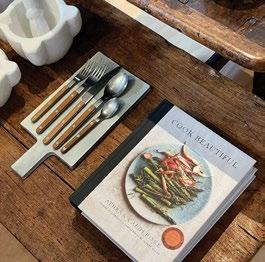




Honestly, the best property in all of the Hamptons. You are on an instant holiday the moment you see the Kuba cloth-clad walls, the twinkly light, and the rolling green lawn that leads right into Lake Montauk at sunset. Pure summer heaven. Then there’s the perfect Mediterranean fare, from the mezze platter to the halibut and new kebab menu—there is nothing not to love!
Okay, this is a gem at the side of the road. Hands down, the best zucchini bread you will ever eat in your life. They also make the best homemade pesto and ricotta. Local asparagus and fruits, veggies, and pies too!
I have to ask why this place is not franchised—the pies, the chicken fingers, the shrimp skewers, the prepared salads, guacamole, dips, and chips. Sure you need to take out a new mortgage but somehow you are okay with it because it’s that good. Such a gem that can provide your household with everything you need for a weekend of entertaining without cooking.

Athena Calderone knew she had found a second home by the dreamy enclave of Springs. Only years later did she discover the artistic ecosystem that laid the bedrock for her own creative coming-of-age.
AS TOLD BY ATHENA CALDERONE AND ADRIAN NIVOLA PHOTOGRAPHY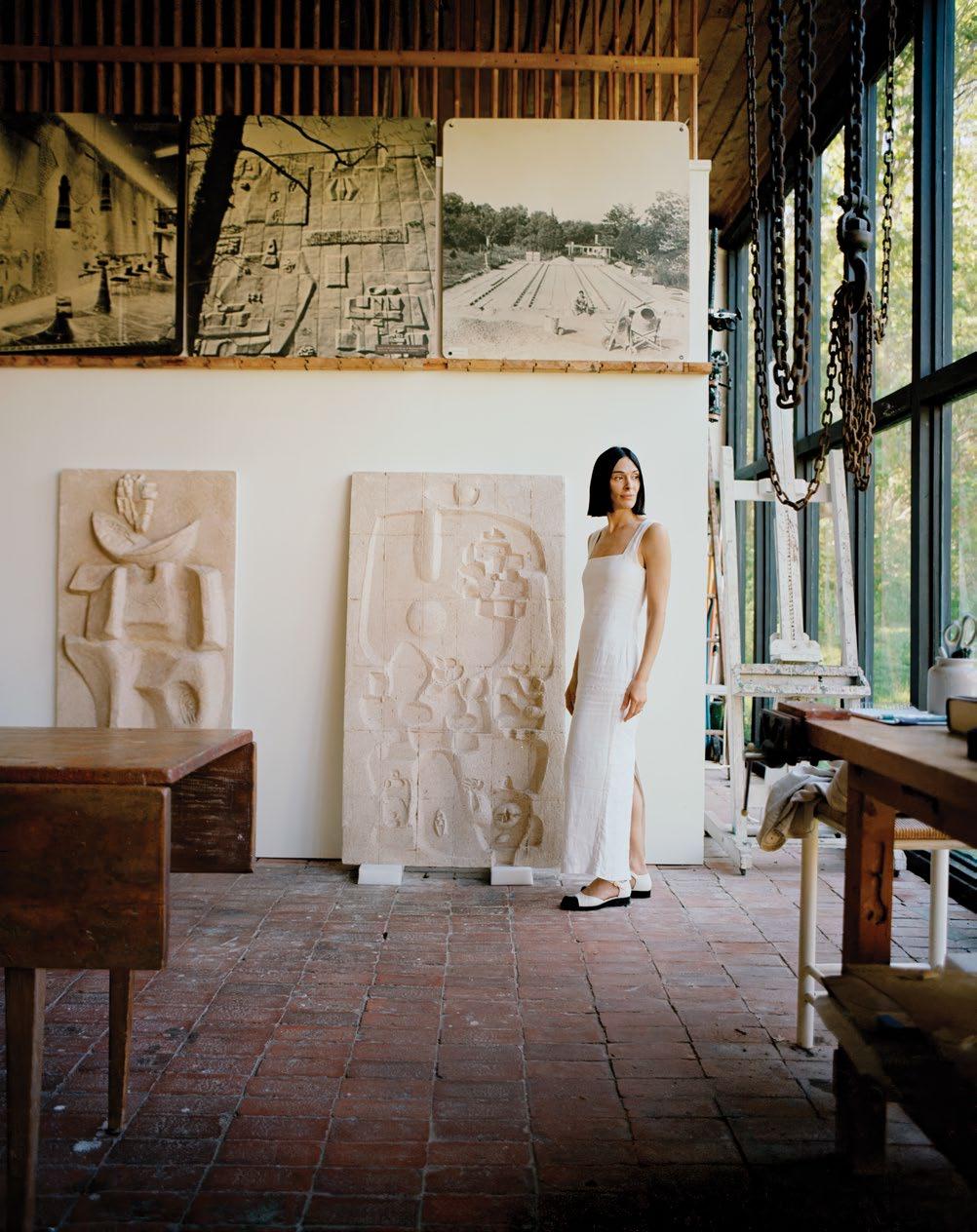

NIVOLA AWOKE in London in late May in the special kind of haze one feels when caring for a 3-month-old baby. Yet his easy demeanor is still felt even through Zoom. He speaks with openness about his family, fluidly recalling stories of his grandparents and the home that has been in his family since 1945. He tells how it all started in Springs—the spirit of this entire place we all lovingly refer to as “out East.”
There, his grandfather, sculptor Costantino “Tino” Nivola, worked with the sand in a style that was nearly undefinable. Yet the way of life that he designed for himself became the blueprint for Hamptons culture as we know it. There was a fluidity between nature and the home and a culture of creation in this place. Springs was home to some of America’s most prominent Abstract Expressionists, from Jackson Pollock to Willem de Kooning, and they gathered at the Nivolas’ to experience a landscape built with memories from another world—Sardinia.
Nivola first immigrated from Italy in 1939 with his German-Jewish wife, Ruth Guggenheim. They landed in New York—living downtown, working in factories, and eventually finding stability when Tino took a job as an art director for Interiors magazine. The city brought them some connections, yet they craved a connection to the land. By 1948, they bought in Springs, just down the road from Jackson Pollock and his wife Lee Krasner,
another artist couple who came to define American Abstract Expressionism.
“My grandfather was an amazing cook,” said Nivola. “He and my grandmother loved to host people in their home and it became a social hub in the Hamptons in the 1950s and 1960s. They invited critics, artists, and all of their community to enjoy this property that he built with his own hands in the Sardinian style.”
It turns out the food was essential, because of the famous 1950s cocktail hour. Costantino found it boring when everyone drank too much and conversation would go off the rails. He discovered a solution that set the tone for the bacchanalian feasts that kept them at the heart of the culture.
“He went to an Italian butcher in the West Village and brought all these prosciutto legs back to Springs, where he hung them in the garden from the trees so people could eat, and it would slow down the process of them being inebriated. It would preserve the conversation,” he said. “He designed the whole compound, piecemeal, with some elements coming directly from Sardinia and combined it with that modernist feel of the time. When I went to Sardina for the first time as a child, I immediately felt familiar with it.”
Over time, Tino turned his property into a living studio for him and Ruth, complete with tons of sand from the beach in the backyard. The playful spirit of the sculptures he made there, with his children Claire and Pietro, became
part of a body of work. Every surface was a canvas for Tino—the ground, the exterior walls, and later, the sand.
In a 2021 show held at Magazzino Italian Art in his honor, then-director Vittorio Calabrese said his work was nearly lost to history because it could not be categorized. It was experimental, often large-scale, and made from found materials. He captured the ephemeral nature of sand by pouring plaster into his geometric carvings. His commission for Olivetti on Fifth Avenue was what made his name. The store, which sold typewriters, was akin to an Apple store of its time, showing a technological future rooted in experiential design. His work seemed to make sense to architects, who commissioned façades for civic and private buildings, including the headquarters of local newsrooms in Bridgeport, Connecticut, and beyond. Despite his close friendships with Pollock and Le Corbusier, Tino never wavered from his own style.
“The artists used to give each other works in progress and lend them to each other to live in their contexts,” said Nivola. “Pollock lent my grandfather a painting. It sat in the living room in the house, and after a while, my grandfather told Pollock he couldn’t live with it. It made him nervous and the children would fight when they were near it. He gave the painting back to Pollock. They were brutally honest with each other in these exchanges and this didn’t rupture their friendship; Pollock gave my dad his first bicycle.” Tino then described how Piet









Mondrian later visited Pollock’s studio, where that painting, titled Stenographic Figure, hung. He loved it and wrote a letter to Peggy Guggenheim saying that Pollock was the most significant American artist of the time. That very painting launched his career and now hangs in the Museum of Modern Art. Nivola recalls a picture of his grandfather looking at it with his head cocked to the side.
For Le Corbusier, it was different. There was a natural alignment between the two artists, who were both skeptical of the American experimentation of the time. Le Corbusier even experimented with sand castings when he stayed in Springs. Le Corbusier’s commitment to honing a painting as though it were a perfect machine was a notion he feared would be lost from the new developments of painting, and he distilled this philosophy with Tino.
Le Corbusier would travel back and forth from France to New York, usually while working on a project for the United Nations. Arriving from his travels, he brought suitcases of sketches and paintings he had been developing for years. Nivola’s grandfather remarked that Le Corbusier often brought more sketches than clothes. He had been searching for the right context to develop a large-scale mural and was drawn to Nivola’s renovation of the formerly dilapidated farmhouse. The concept for the resulting mural had been previously sketched and refined by Corbusier for some time. The mural was painted over a two-day period in the Nivola house, after Tino ran out to get paints for Le Corbusier. There it stayed, in the same spot where the Pollock once sat in the home.
This home is a quiet center-point for the creative life in the Hamptons, born out of Tino’s connection to the land, which helped him find his voice as a multifaceted artist. In turn, he created a destination for a community of artists who, like him, found inspiration in the isolation and connectivity to nature, as well as the space to express themselves in new and innovative ways. This original band of artists created these pillars of life from Springs. Today, we all walk in their footsteps.




“MY WORK IS ALWAYS DEVELOPED with artwork in mind,” asserts Sandra Weingort. The Colombian-born, Miami- and New York-based interior designer ensures her clients are collectors before determining whether a project is the right fit for her firm. She launched the eponymous studio in 2012 after working for nearly a decade at the influential Studio Sofield. In that time, she developed a knack for pairing paintings and sculpture with carefully curated furniture collections.
In 2020, the opportunity arose to do so on the highest level, when Weingort was approached to work on a sweeping 11,000-square-foot Wainscott, New York, residence constructed by Bates Masi + Architects. “The clients approached Bates Masi with a desire to build a home that would prominently display a significant art collection while maintaining views of the landscape and protecting the art from sunlight,” explains Weingort. Despite her usual preference for signing onto projects prior to construction, the opportunity was too intriguing to pass up. “While this was a departure from my usual workflow, it presented a fascinating reversal of the typical order of things,” she says.
A team was assembled as pieces started to flow into the home, with Weingort scouting Le Corbusier lamps, Pierre Jeanneret chairs, and Isamu Noguchi tables. Art advisor Alex Glauber, principal of AWG Art Advisory and consultant to the family since 2017, slotted in works by Dan Flavin, Claes Oldenburg, Cecily Brown, Alex Katz, Ed Ruscha, Takashi Murakami, Lucy Dodd, and more. “While I may not know which specific pieces will inhabit each room, the design is crafted to complement rather than overshadow the art,” Weingort explains. “This doesn’t mean the furniture collection is too subdued or neutral, as this can cause the art to dominate, which is also not ideal. Everything should converse in a coherent language, whether through contrast or similarity.” In the Wainscott residence, it’s the oft-discussed Hamptons light that accentuates Sangort’s splashes of color and polished design indoors. Even when no one is around, the house has plenty to respond to.


and his husband, Mario Margelist-Carlyle, had even finalized the purchase of their East Hampton farmhouse inspired by 18th-century Georgian colonial architecture, Carlyle had already made the impetuous decision to commission a sizable piece of art: an angular, charcoalblack polished aluminum sculpture by the artist Bill Wood. “I thought it would be really fabulous if you had a contemporary sculpture to the left of the house as you drive in, to juxtapose the traditional architecture,” says the founder and principal of the Manhattan-based Carlyle Designs. It was an especially daring move considering the couple hadn’t yet landed on any other aspect of their design plan—inside or out.
“We had no clue what we’d end up doing, other than not wanting the house to feel like you’re walking into any other Hamptons house with, you know, a spindle staircase or white hydrangeas out front when you drive in,” explains Carlyle.
That manifesto eventually resulted in impossibly zen interiors, awash in neutral tones and layered with tactile surfaces. Outside (apologies to any devotees of white hydrangeas), there’s not a single showy blossom in sight. Instead, the couple opted to let nature drive the narrative. The Bill Wood sculpture is there—evoking their own private Storm King, with its slanted structure quietly embedded in its surroundings, but also acting as a striking representation of its owners’ ability to adroitly execute their vision no matter what.
Working in tandem with landscape designer Robin Kramer, the couple initially presented a detailed plan for the 1.75acre property showcasing various cutting gardens and areas to step into, each abundant with greenery and indigenous flowers. However, they soon learned they were dealing with less area than originally expected: only one acre. “The remaining acreage is scenic reserves, so you can’t touch it,” says Carlyle. “We didn’t realize


“We had no clue what we’d end up doing, other than not wanting the house to feel like you’re walking into any other Hamptons house.”
— JORDAN CARLYLE

you had these restrictions when it came to what you could actually plant or what you could clear.” To make the most of what was usable, they shrewdly abandoned their initial vision of neatly formed cutting gardens in favor of a more open, organicfeeling sprawl.
A pool is situated at the far edge of the landscaped property, while an understated ivory stone table awaits beneath a painted black pergola. Beyond it sits another sculpture: stacked slabs of Cor-Ten steel by the artist Joy Dutta. Punctuating the property’s bounds, every feature becomes its own destination, each with its own prized time of day to claim. “We have sunlight on the pool from 7 in the morning until 7 at night. Before dinner, we’ll sit outside and have cocktails by the firepit, and then of course, if we’re entertaining, the pergola is magical in the summertime,” Carlyle says, adding that a typical summer menu might feature the area’s local bounty—a peach and heirloom tomato salad with burrata, and a grilled whole branzino, for example.
This summer, after several years of cultivation and growth, there’s finally a three-foot meadow running along the property’s perimeter. This sweet pastoral touch enhances the feeling of romantic remoteness availed by the house’s place at the end of a cul-de-sac. “We’re the farthest away from any road or traffic,” notes Carlyle, “so it’s just complete silence other than birds and nature.”



SIXTEEN YEARS AGO, ARCHITECT ADAM JORDAN HELPED PAUL MASI CONSTRUCT ATHENA CALDERONE’S AMAGANSETT HOME. HERE, THE PAIR RECONNECT TO DISCUSS THE EVOLUTION OF JORDAN’S PRACTICE—EMBODIED IN THE STANDOUT DESIGN OF A U-SHAPED EAST HAMPTON PROPERTY BY THE WATER—AND HIS AESTHETIC SENSIBILITIES.
PHOTOGRAPHY BY ERIC PETSCHEK
ATHENA CALDERONE: I love that your 2015 Shagwong residence allowed us to be reacquainted all these years after we worked together alongside Paul Masi on my Amagansett home. I was immediately drawn to its design, materiality, and architecture long before I knew it was yours. Can you speak to your architectural point of view?
ADAM JORDAN: Working on your Amagansett home was a great pleasure with so many fond memories. European design sensibilities, which I interpret as a reverence for history, attention to detail, and commitment to craftsmanship, are fundamental to my design approach. My architectural point of view is to craft refined, thoughtful, and timeless spaces that embody the unique needs of each client. I am drawn to an edited design language that prioritizes simplicity, warmth, and materiality with an unwavering dedication to detail and craftsmanship.
CALDERONE: Can you share more about the layout of the Shagwong residence, particularly the U-shaped design and your choice to integrate a courtyard that allows each space to connect to the outdoors? I am also curious how you intended the experience to be for someone initially entering the home. That entry hall leading to the waterfront is most certainly a “wow” moment. Tell us more about your vision for the flow of this home and how you blurred the line between indoors and out.
JORDAN: The U-shape design was a result of our close collaboration with the client and their unique requests. At our first meeting, the client’s brief requested
a single-story home that allowed water views for each space. This turned out to be challenging given the property’s narrow width, but after some design exploration, we developed the idea of a U-shaped home with the interior spaces oriented around a central courtyard. High-priority spaces—including the living area, dining area, kitchen, and main suite—are located in the wing closest to the water, allowing for unobstructed views. Secondary spaces—including the guest rooms and office—are in the opposite wing but are granted water views through strategically placed windows overlooking the courtyard.
With respect to the entry hall, a recurring theme in our work is to create a sense of exploration and reveal as one navigates the home. Working with the client, we made the decision to treat the front of the home as a solid volume, acting as a veiled curtain concealing the vast water views beyond.
The main entry door is recessed within a deep porch, clad with dark-stained siding, further reinforcing the veiled entry into the home. Once the door is opened, you are presented with a light-filled entry hall framing the expansive water views alongside a large expanse of glass overlooking the central courtyard.
CALDERONE: Is the land and surrounding property always a starting point as you approach each project?
JORDAN: The site and its surroundings are always some of the first considerations in our design process. Each project begins with an in-depth study of the site, its topography, orientation, vegetation, and existing structures. Fortunately, many of our projects are

“EMBRACING TRADITIONAL BUILDING TECHNIQUES AND MATERIALS WHILE REINTERPRETING IN A REFINED DESIGN LANGUAGE IS A FOUNDATIONAL THEME IN MY WORK.”
— ADAM JORDAN
situated in beautiful settings, allowing us to design spaces that embrace thoughtful use of natural lighting and curated views of the surrounding landscape. Understanding and embracing a project’s natural context allows us to create a harmonious relationship between a home and its surroundings.
CALDERONE: I’d love to learn more about how you work with clients. How do you incorporate their needs, lifestyle, and personality while still staying true to your design identity?
JORDAN: Our approach to working with clients is deeply collaborative. Designing a home is very personal, and we strive to include our clients in every step, ensuring
their dreams and aspirations are embodied in the final product. Even though we have a distinct style that our clients seek out, we begin our projects looking at inspiration images, which can range from past projects to abstract imagery. We recently used an image of an old brick wall found on a client’s property that influenced our material selections and honored the historic building materials in the surrounding area. We then take those sources of inspiration, alongside our client’s brief, and begin developing designs with hand sketches and eventually work our way to computer renderings and plans. Throughout this process, we continuously meet and develop with our clients, ensuring that every decision aligns with their goals.
“I AM A MINIMALIST AT HEART BUT DEEPLY DRAWN TO SPACES THAT ARE WARM AND INVITING.”
— ADAM JORDAN
CALDERONE: Can you share some of your architectural mentors and identify where your sense of aesthetics comes from?
JORDAN: I am a minimalist at heart but deeply drawn to spaces that are warm and inviting. Embracing traditional building techniques and materials while reinterpreting in a refined design language is a foundational theme in my work. The merging of these two ideas imbues an element of history and patina into our designs, resulting in spaces that are livable, comfortable, and exude character.
I personally draw inspiration from past design visionaries ranging from architects to furniture designers—[Ludwig] Mies van der Rohe, Frank Lloyd Wright, Louis Kahn, Charlotte Perriand, and Pierre Chapo, to name a few. A contemporary architect who was not only an inspiration but a good friend in my early career was Harry Bates. A prolific 20th-century modernist, Harry designed many homes on Long Island that are incredible works of modern architecture due to their understated elegance that seamlessly merges into their surroundings. Harry’s knowledge, passion, and incredible stories are all fond memories that played an important role in my early career.
CALDERONE: You branched out to start your own multidisciplinary design firm in 2014. What have been some highlights in growing a firm? How do you continue to evolve?
JORDAN: Starting my own firm has been a dream come true, primarily due to the creative freedom it provides and the meaningful connections I make with so many incredible people. It’s deeply
fulfilling as a naturally creative individual to bring ideas to life. Knowing that these creations will become the backdrop for people’s lives, where they’ll build memories and grow, is a profoundly humbling experience. Developing a design identity is a gradual process that I feel is influenced by life, experiences, and inherent personal preferences. While I’ve always been a minimalist, my wife’s preference for softer, vintage, and whimsical designs has influenced my own tastes in a positive way. The merging of these two design influences can be seen in my work through the combination of warm, livable, and patinated spaces that are rigorously detailed.
CALDERONE: The most amazing part about reconnecting is collaborating with you once again on the architecture of the annex on our Amagansett property. I knew you would design a secondary space that aesthetically aligned with the original architecture, but with a fresh take. It feels like such a full-circle moment as we have both evolved so much since then. I would love to ask your opinion about collaboration in general when working with another designer.
JORDAN: I believe that architecture and interior design are inherently connected, and when they complement each other, [they] create a cohesive and thoughtful environment. I have found that working with other talented designers, who respect each other’s work, often leads to new and unique design solutions that further enhance the inseparable connection between architecture and interiors.



4 Newtown Ln., East Hampton, NY 11937 • Monday – Sunday | 10–6PM The Garage at 62 Newtown Ln., East Hampton, NY 11937 • Open by appointment only ericfirestonegallery.com
